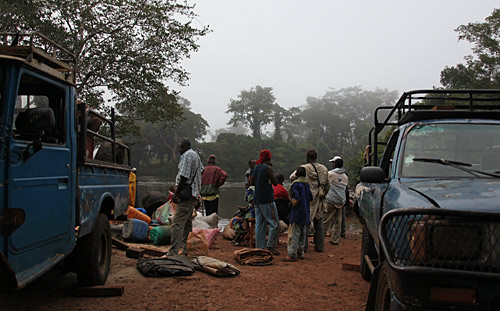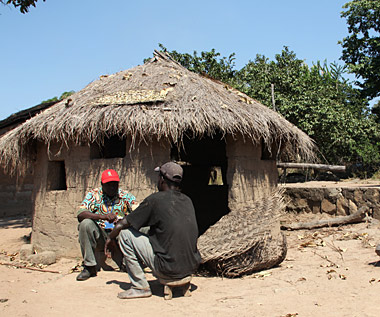Researchers document human toll of violence in Central African Republic
UC Berkeley human rights researchers have systematically canvassed nearly 2,000 households in the Central African Republic to document the devastating human impact of violence in the country. They present a stark picture of a population traumatized by decades of political strife, military coups and poverty.
August 3, 2010
Using a combination of scientific methodology and old-fashioned legwork, human rights researchers based at the University of California, Berkeley, have systematically canvassed nearly 2,000 households in the Central African Republic, carefully documenting the devastating human impact of violence in the country, as well as detailing the opinions of how the country should move forward.
Their findings are detailed in a study to appear in the Aug. 4 issue of the Journal of the American Medical Association (JAMA) and in a complementary report to be released the same day by the UC Berkeley Human Rights Center. The researchers present a stark picture of a population traumatized by decades of political strife, military coups and poverty.
The health and mortality data are reported in the JAMA study, while the results of the survey on attitudes about accountability and social reconstruction are laid out in the report, “Building Peace, Seeking Justice.”
Both papers stem from the Initiative for Vulnerable Populations, a project based at the Human Rights Center. The initiative was established to document the consequences of international humanitarian law violations and to give a voice to victims of serious crimes. Patrick Vinck and Phuong Pham, who have joint research appointments at the Human Rights Center and at Tulane University’s Payson Center for International Development, authored both the JAMA study and the report.
Trained interviewers spent an hour or more each with 1,879 adults, gathering information about their exposure to violence, sense of security, physical well-being and mental health. The numbers are striking:
- Mortality rates averaged 4.9 deaths per 1,000 people per month, a level 3 to 5 times higher than the average for sub-Saharan Africa, and among the highest in the region
- 81 percent said they had to flee their homes since 2002
- 67 percent said they had been threatened with death
- 11 percent reported having been abducted
- 16 percent said they had been coerced to work with armed groups and sometimes forced to commit violence
Moreover, a high percentage of survey respondents reported witnessing or experiencing traumatic events, and more than half of the respondents reported symptoms consistent with depression and anxiety.

Villagers wait along the shores of one of the many rivers in the Central African Republic that lack bridges or functioning barges. Crossing is only possible using pirogues. The bad shape of the road and transportation network in the country hinders trade and exchange. A survey by researchers at UC Berkeley’s Human Rights Center found a high rate of mortality, depression and anxiety in the country.
“What we found in the Central African Republic is one of the worst cases of a humanitarian crisis,” said Vinck. “Violence has played a role in destroying the country’s infrastructure, but there have also been decades of failure to provide services to the population. Roads are lacking, schools are lacking, health centers are lacking. Even in areas that are not undergoing conflict, the schools are just stables with four poles, a roof and benches made from logs of wood.”
The Central African Republic is one of the world’s most impoverished countries, ranked 179th out of 182 countries on the United Nation’s human development index, which reflects a country’s health, education and income status. The republic’s current head of state, Francois Bozize, rose to power in 2003 through a military coup.
The researchers behind the Central African Republic survey seek to inform aid programs, security sector reforms to protect civilians, and accountability processes, including proceedings at the International Criminal Court, an independent organization governed by the Rome Statute, a treaty ratified by 111 countries.
One of the most high-profile cases currently before the court is the trial of Jean-Pierre Bemba, a former vice president of the Democratic Republic of the Congo and a second runner-up in Congo’s 2006 presidential election. Bemba led fighters from the Movement for the Liberation in 2002 in a failed attempt to put down Bozize’s coup in the Central African Republic. Bemba stands accused of murdering and raping civilians in that process.
“Human rights investigations typically include victim narratives, which are extremely important in providing in-depth and compelling stories that illustrate abuses, but the narratives do not necessarily tell you about the scope or intensity of violence within a population,” said Pham, an epidemiologist by training who helped apply the rigors of survey methodology to the field of human rights. “What we are bringing to the table are numbers that convey prevalence and incidence. Once you have numbers, you can’t deny that there’s a problem, and that it’s widespread.”
“Our work explores systematic and widespread patterns of violence, as well as the views of the population on how to address and resolve such violence,” Vinck added. “Unaddressed, these issues could further undermine Central African Republic’s development and slow its progress toward social reconstruction.”

Workers conduct a mock interview in front of a Central African Republic home. During the actual survey, the interviewers, who received thorough training before heading out into the field, spent an hour or more with each respondent.
In the Central African Republic survey, the researchers targeted five administrative regions: two in the north where violence continues, and three in the south, which has not experienced the same level of violence for several years. The five regions, including the capital, Bangui, account for half the country’s population. Villages and neighborhoods were randomly selected, and households were chosen with the spin of a pen.
While the mortality rates were higher in the more violence-plagued northern regions, the researchers noted that the death rates were still exceedingly high in the relatively violence-free south.
“That pattern suggests a chronic, endemic situation,” said Pham. “And while it is hard to rank poverty and insecurity, it’s clear that this country is more neglected than its neighbors when it comes to humanitarian aid.”
Yet in the midst of this devastation, the researchers found reason to be hopeful.
In “Building Peace, Seeking Justice,” they report that most respondents — 61 percent — consider the conflict to be predominantly political. “It’s not a conflict among the people,” said Vinck. “It’s a conflict among political factions fighting for power, but that can be more straightforward to resolve. It’s possible for the international community to put enough tension and pressure on the political groups to help to bring more security to the population. Once security is achieved, there is an urgent need to develop services outside of the capital city.”
Ninety-four percent of the respondents said they plan to vote in the next presidential elections, and most felt confident that they would be able to vote freely. Presidential elections were scheduled for March 2010, but have been delayed several times.
When asked how those responsible for the violence should be prosecuted, 52 percent said they should be tried in the national courts while 27 percent said they should be tried in the Central African Republic by an international court. Only 14 percent preferred international trials outside of the country.
“These findings are in line with those from other post-conflict regions,” said Vinck. “The people want trials to be conducted in their own country in order to witness and participate in the process. To build lasting peace, it is important to take the opinions of the war-affected communities into account. One of our recommendations to the International Criminal Court is to consider holding court proceedings in the Central African Republic, security permitting, because of the strong support for local trials.”
The Central African Republic survey is the latest study in the Great Lake region of Africa conducted by Vinck and Pham. They have conducted previous human rights surveys among affected communities in the Democratic Republic of Congo, Rwanda and Uganda, among others.
“The voice of the people is rarely taken into account in decisions and policy making in these regions,” said Vinck. The risk of not listening to what the people want is to develop policies that are not appropriate or that do not meet the people’s needs, the authors said.
The John D. and Catherine T. MacArthur Foundation and Humanity United helped support this project.